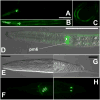Strongyloides stercoralis: cell- and tissue-specific transgene expression and co-transformation with vector constructs incorporating a common multifunctional 3' UTR
- PMID: 17945217
- PMCID: PMC2259275
- DOI: 10.1016/j.exppara.2007.08.018
Strongyloides stercoralis: cell- and tissue-specific transgene expression and co-transformation with vector constructs incorporating a common multifunctional 3' UTR
Abstract
Transgenesis is a valuable methodology for studying gene expression patterns and gene function. It has recently become available for research on some parasitic nematodes, including Strongyloides stercoralis. Previously, we described a vector construct, comprising the promoter and 3' UTR of the S. stercoralis gene Ss era-1 that gives expression of GFP in intestinal cells of developing F1 progeny. In the present study, we identified three new S. stercoralis promoters, which, in combination with the Ss era-1 3' UTR, can drive expression of GFP or the red fluorescent protein, mRFPmars, in tissue-specific fashion. These include Ss act-2, which drives expression in body wall muscle cells, Ss gpa-3, which drives expression in amphidial and phasmidial neurons and Ss rps-21, which drives ubiquitous expression in F1 transformants and in the gonads of microinjected P0 female worms. Concomitant microinjection of vectors containing GFP and mRFPmars gave dually transformed F1 progeny, suggesting that these constructs could be used as co-injection markers for other transgenes of interest. We have developed a vector "toolkit" for S. stercoralis including constructs with the Ss era-1 3' UTR and each of the promoters described above.
Figures






Similar articles
-
Successful transgenesis of the parasitic nematode Strongyloides stercoralis requires endogenous non-coding control elements.Int J Parasitol. 2006 May 31;36(6):671-9. doi: 10.1016/j.ijpara.2005.12.007. Epub 2006 Feb 7. Int J Parasitol. 2006. PMID: 16500658
-
Heritable genetic transformation of Strongyloides stercoralis by microinjection of plasmid DNA constructs into the male germline.Int J Parasitol. 2017 Aug;47(9):511-515. doi: 10.1016/j.ijpara.2017.04.003. Epub 2017 Jun 1. Int J Parasitol. 2017. PMID: 28577882 Free PMC article.
-
Transgene expression in Strongyloides stercoralis following gonadal microinjection of DNA constructs.Mol Biochem Parasitol. 2002 Feb;119(2):279-84. doi: 10.1016/s0166-6851(01)00414-5. Mol Biochem Parasitol. 2002. PMID: 11814580 No abstract available.
-
Strongyloides stercoralis: a model for translational research on parasitic nematode biology.WormBook. 2007 Feb 17:1-18. doi: 10.1895/wormbook.1.134.1. WormBook. 2007. PMID: 18050500 Free PMC article. Review.
-
The 'nuclear option' revisited: Confirmation of Ss-daf-12 function and therapeutic potential in Strongyloides stercoralis and other parasitic nematode infections.Mol Biochem Parasitol. 2022 Jul;250:111490. doi: 10.1016/j.molbiopara.2022.111490. Epub 2022 Jun 11. Mol Biochem Parasitol. 2022. PMID: 35697206 Review.
Cited by
-
Lentiviral Transduction-based CRISPR/Cas9 Editing of Schistosoma mansoni Acetylcholinesterase.Curr Genomics. 2023 Nov 22;24(3):155-170. doi: 10.2174/1389202924666230823094608. Curr Genomics. 2023. PMID: 38178986 Free PMC article.
-
Structural and developmental expression of Ss-riok-2, an RIO protein kinase encoding gene of Strongyloides stercoralis.Sci Rep. 2017 Aug 18;7(1):8693. doi: 10.1038/s41598-017-07991-2. Sci Rep. 2017. PMID: 28821723 Free PMC article.
-
Carbon dioxide shapes parasite-host interactions in a human-infective nematode.Curr Biol. 2025 Jan 20;35(2):277-286.e6. doi: 10.1016/j.cub.2024.11.036. Epub 2024 Dec 23. Curr Biol. 2025. PMID: 39719698
-
The role of carbon dioxide in nematode behaviour and physiology.Parasitology. 2020 Jul;147(8):841-854. doi: 10.1017/S0031182019001422. Epub 2019 Oct 11. Parasitology. 2020. PMID: 31601281 Free PMC article. Review.
-
Transgenesis in Strongyloides and related parasitic nematodes: historical perspectives, current functional genomic applications and progress towards gene disruption and editing.Parasitology. 2017 Mar;144(3):327-342. doi: 10.1017/S0031182016000391. Epub 2016 Mar 22. Parasitology. 2017. PMID: 27000743 Free PMC article. Review.
References
-
- Ashton FT, Bhopale VM, Fine AE, Schad GA. Sensory neuroanatomy of a skin-penetrating nematode parasite: Strongyloides stercoralis. I. Amphidial neurons. J Comp Neurol. 1995;357:281–95. - PubMed
-
- Ashton FT, Bhopale VM, Holt D, Smith G, Schad GA. Developmental switching in the parasitic nematode Strongyloides stercoralis is controlled by the ASF and ASI amphidial neurons. Journal of Parasitology. 1998;84:691–695. - PubMed
-
- Britton C, Redmond DL, Knox DP, McKerrow JH, Barry JD. Identification of promoter elements of parasite nematode genes in transgenic Caenorhabditis elegans. Molecular and Biochemical Parasitology. 1999;103:171–81. - PubMed
Publication types
MeSH terms
Substances
Associated data
- Actions
- Actions
- Actions
- Actions
Grants and funding
LinkOut - more resources
Full Text Sources
Research Materials

